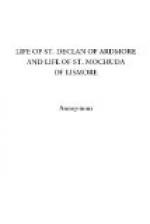The foregoing charges may, or must, be admitted partially or in full, but such admission implies no denial of the historical value of the Lives. All archaic literature, be it remembered, is in a greater or less degree uncritical, and it must be read in the light of the writer’s times and surroundings. That imagination should sometimes run riot and the pen be carried beyond the boundary line of the strictly literal is perhaps nothing much to be marvelled at in the case of the supernatural minded Celt with religion for his theme. Did the scribe believe what he wrote when he recounted the multiplied marvels of his holy patron’s life? Doubtless he did—and why not! To the unsophisticated monastic and mediaeval mind, as to the mind of primitive man, the marvellous and supernatural is almost as real and near as the commonplace and natural. If anyone doubts this let him study the mind of the modern Irish peasant; let him get beneath its surface and inside its guardian ring of shrinking reserve; there he will find the same material exactly as composed the mind of the tenth century biographers of Declan and Mochuda. Dreamers and visionaries were of as frequent occurrence in Erin of ages ago as they are to-day. Then as now the supernatural and marvellous had a wondrous fascination for the Celtic mind. Sometimes the attraction becomes so strong as seemingly to overbalance the faculty of distinguishing fact from fancy. Of St. Bridget we are gravely told that to dry her wet cloak she hung in out on a sunbeam! Another Saint sailed away to a foreign land on a sod from his native hillside! More than once we find a flagstone turned into a raft to bear a missionary band beyond the seas! St. Fursey exchanged diseases with his friend Magnentius, and, stranger still, the exchange was arranged and effected by correspondence! To the saints moreover are ascribed lives of incredible duration—to Mochta, Ibar, Seachnal, and Brendan, for instance, three hundred years each; St. Mochaemog is credited with a life of four hundred and thirteen years, and so on!
Clan, or tribe, rivalry was doubtless one of the things which made for the invention and multiplication of miracles. If the patron of the Decies is credited with a miracle, the tribesmen of Ossory must go one better and attribute to their tribal saint a marvel more striking still. The hagiographers of Decies retort for their patron by a claim of yet another miracle and so on. It is to be feared too that occasionally a less worthy motive than tribal honour prompted the imagination of our Irish hagiographers—the desire to exploit the saint and his honour for worldly gain.
The “Lives” of the Irish Saints contain an immense quantity of material of first rate importance for the historian of the Celtic church. Underneath the later concoction of fable is a solid substratum of fact which no serious student can ignore. Even where the narrative is otherwise plainly myth or fiction it sheds many a useful sidelight on ancient manners, customs and laws as well as on the curious and often intricate operations of the Celtic mind.




